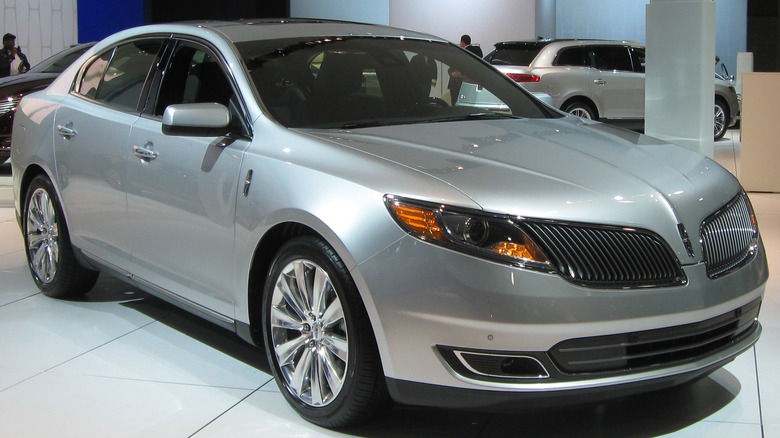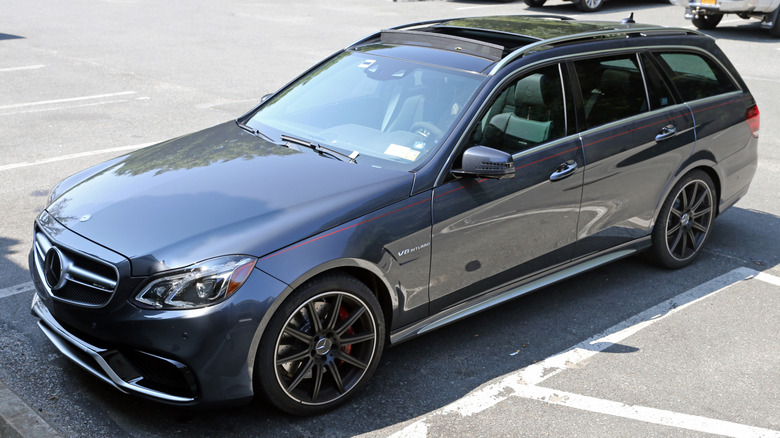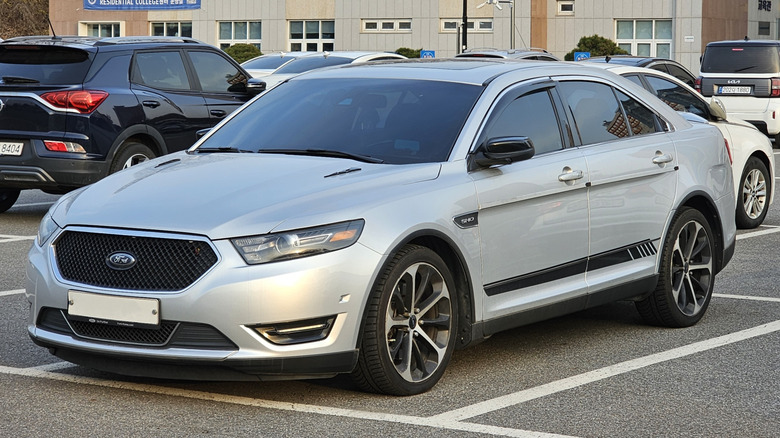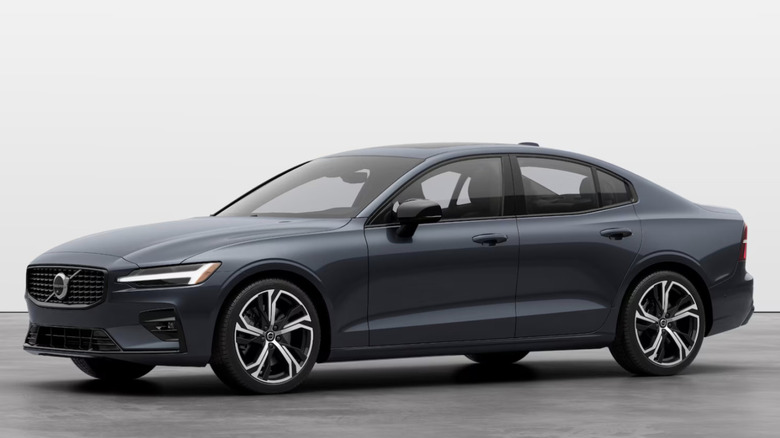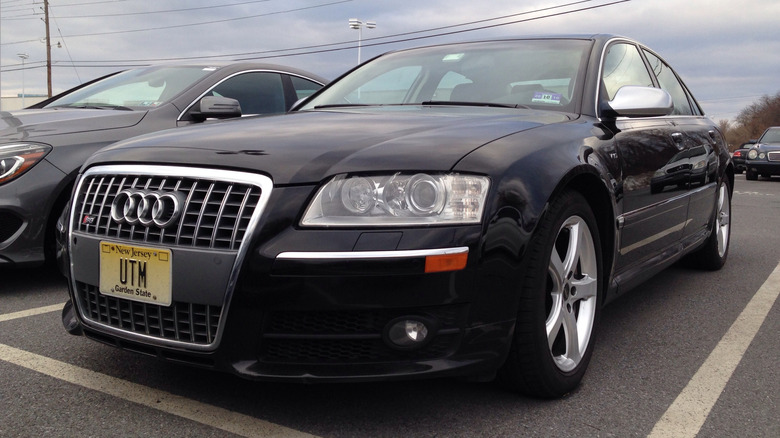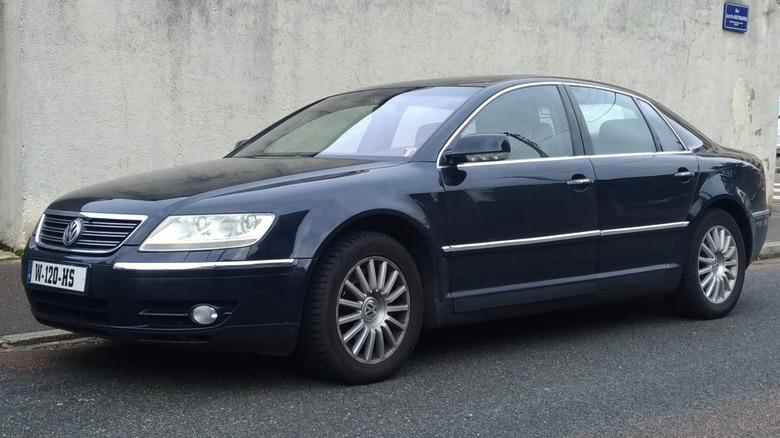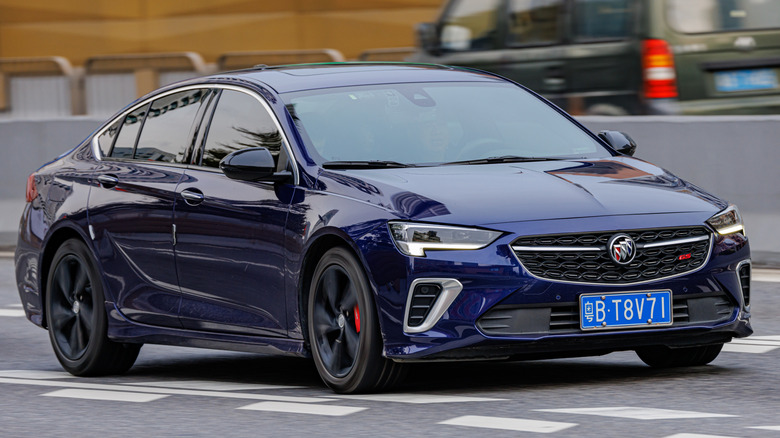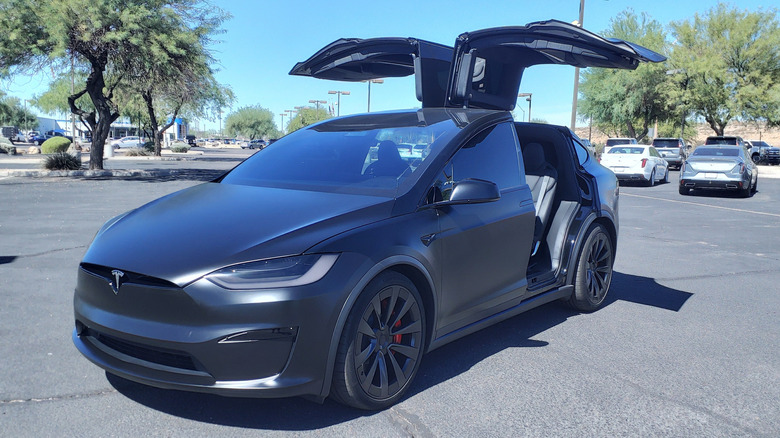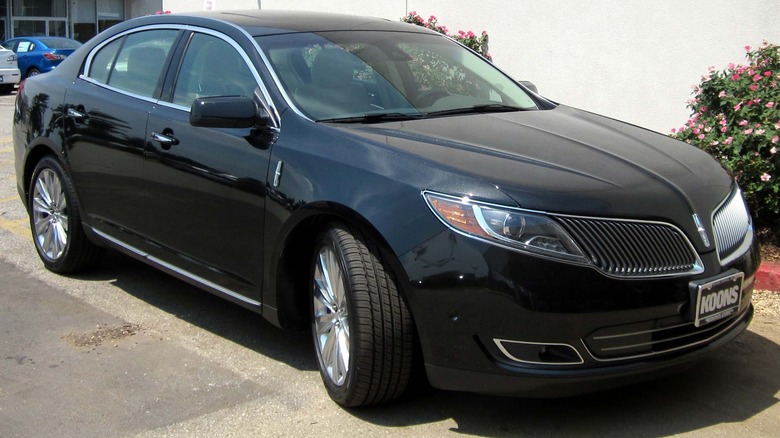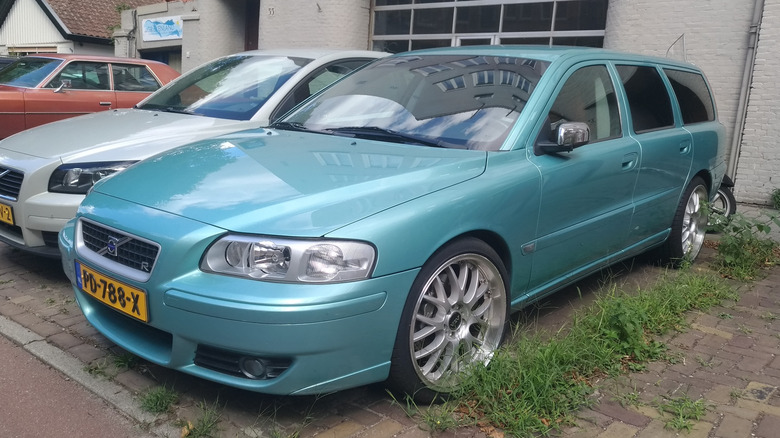13 Fast Cars That Look Slow
There are two kinds of cars in this world ... Well, there are actually more than two kinds, but for the purpose of this story, just roll with me, okay?
There are two kinds of cars in this world: cars built for speed, and cars built for utility. Speedy cars are generally small, light, and powered by strong engines, while utility cars are big and bulky to carry multiple passengers and cargo.
Sometimes, though, a car can check both boxes. In Star Wars, when Han Solo describes his spaceship, The Millennium Falcon, he says, "She might not look like much, but she's got it where it counts." Likewise, these cars don't look like they can zip around a racetrack, but they've got surprising pep. They might not have the appearance of the fastest vehicles on the road, but looks can be deceiving. When looking for a car, aerodynamic curves are one thing, but you also want something that can hold some junk in its trunk, so to speak. Let's take a look at 13 fast cars that look slow.
Mercedes E63 AMG S Wagon
You're probably never gonna see Vin Diesel behind the wheel of a station wagon in a Fast & Furious movie, which is ironic, since it's the perfect vehicle for "family." When it comes to station wagons, our minds think less like Fast & Furious, and more like National Lampoon's Vacation.
However, if there's one station wagon that might change his mind, it's the Mercedes E63 AMG S Wagon. It might look like a typical frumpy family car, but the AMG moniker (named for engineers Aufrecht and Melcher, and Aufrecht's hometown of Großaspach) means that any car with that designation is built for performance, regardless of appearance. In that respect, the E63 delivers, with the 2021 model capable of going from 0-60 mph in just 3 seconds, thanks to an engine producing over 600 horsepower.
If not for the screaming kids in the backseat, you might forget that you're driving a big ol' station wagon. Although, given the metaphor we started with, it would probably be Tyrese Gibson and Ludacris back there instead of kids.
Ford Taurus SHO
The Ford Taurus is one of the most generic vehicles ever made. It's an all-around reliable model, but wholly unremarkable from an aesthetic perspective. However, alongside the regular Taurus, Ford also released the Taurus SHO. The "SHO" moniker stands for "Super High Output," which means that, while the Taurus SHO might look like any other car on the road, it's a sure bet it can outperform any other car that crosses its path.
The Taurus SHO was first introduced in the late 1980s and ran through 1999. In 2010, the SHO was revived for a new run that lasted until 2019. The 2012 Taurus SHO appeared in Men in Black III, replacing the old Crown Vic from the original film, which Will Smith had derisively referred to as "a Ford P.O.S." Of course, that was before he pushed "the little red button." The real-life Taurus SHO technically doesn't have a "little red button," but with the 2012 model's 365 horsepower engine bringing the car from 0-60 mph in just 5.2 seconds, you won't need one.
Volvo S60 R
The Volvo S60 is a completely unremarkable vehicle. If it was simply called the "Volvo Car," nobody would blink an eye. It gets you where you need to go with no frills. There's nothing wrong with being unremarkable, as long as it's reliable, and the Volvo S60 is nothing if not reliable. But what if the S60 had some real power under the hood?
Enter the Volvo S60 R, with the "R" designation representing vehicles tuned and designed for maximum performance while maintaining the unassuming facade of the base model. The "R" turns the Volvo S60 from an unremarkable car into something any automobile connoisseur would be proud to drive. The 2006 edition features a five-cylinder engine with 300 horsepower that can bring the car from 0-60 mph in 6.6 seconds. That performance comes at a cost, but for auto enthusiasts, particularly those who spend a lot of time on the highway, the MSRP of $37,920 should be worth it.
Volvo XC60 T6 Super-Turbo
There's a lot of buzzwords in the realm of cars: supercharge, turbocharge, EcoBoost, etc. But what do they really mean? Sometimes they mean nothing, but sometimes they make all the difference in the world. With that in mind, let's take a look at the Volvo XC60 T6 Super-Turbo. On the surface, "Super-Turbo" sounds like a nonsense marketing term, but in reality, it's supercharged in the automobile dictionary definition of the term, and it's also turbocharged in the automobile dictionary definition of that term. So, it's truly Super-Turbo. It sounds like marketing nonsense, but it's real.
It's a step above the T5 engine and can go from 0-60 mph in 6 seconds flat. That's mighty impressive, especially considering the sheer size of the XC60. As a luxury crossover SUV, the vehicle weighs in at a hefty 4,000 pounds. It takes a lot of power to move a vehicle like that, but the T6 Super-Turbo engine has what it takes to effectively transform the Volvo XC60 into a shockingly performant quasi-racer. SUVs have a reputation for being slow and lumbering, but the Volvo XC60 challenges that stereotype with its eager powertrain.
Mercedes-Benz G65 AMG
Here's another AMG car, like the station wagon we discussed earlier. This time, the AMG branding goes to Mercedes-Benz's G65, a burly hulk of an off-road machine. Whether you're on a dirt road, a pristine highway, or a mountain incline, the G65 AMG will get you there, and it'll get you there faster than most of its peers.
In the United States, the G65 AMG was sold in model years 2016 through 2018 and was powered by a V12 engine delivering 621 horsepower, capable of bringing the vehicle from 0-60 mph in just a hair over 5 seconds. Not bad for a car that weighs more than 6,000 pounds. So, how much does it cost to have the biggest, most intimidating vehicle this side of an M1 tank? Brace yourself: The 2016 version launched at a base price of $218,000, not including optional upgrades. Presumably, power windows cost extra.
Ford F-150
The Ford F-150 is already a raging beast of a truck, the 4x4 by which all others are judged. Throw in a 2.7L EcoBoost V6 engine, and you've got yourself something truly special. The engine provides 325 horsepower, enough to allow the F-150 to be a reliable towing vehicle. But when not used as an ad hoc U-Haul, this iteration of the F-150 can hit some pretty high speeds.
The 2021 model can go from 0-60 mph in just over 6 seconds. For a vehicle that weighs no less than 5,270 pounds, that's quite impressive, though if you're in a situation where you need to push the speedometer on an F-150, you're probably doing something wrong. Or maybe you just want to put the 2.7 EcoBoost V6 to the test. In terms of fuel efficiency, you can still get over 20 mpg, at least on the highway, but if you're looking for a more environmentally friendly version of the car, then you might be more interested in the electric-powered F-150 Lightning.
Volkswagen Passat W8
Motor enthusiasts are surely familiar with V6, V8, or even V12 engines, but fewer are aware of the W8, a configuration used by Volkswagen. The W8 was only ever used on the Volkswagen Passat W8, which ran from 2001 to 2004. It's a shame, too, since the Passat took full advantage of its engine to really fly down the road with 270 horsepower of motor strength.
By many accounts, the W8 was an ambitious engine, but not to such a degree as to justify its high price. The 2001 Passat W8 launched with an MSRP of over $37,000, or $14,000 more than the base model. However, for those with money to burn who made the choice to take the plunge, the Passat W8 was a one-of-a-kind vehicle. Ultimately, the W8 experiment paved the way for Volkswagen Group's later W12 and WR12 engine development, though the W12 would be officially retired in 2024. As it stands, the Passat W8 is a snapshot of history and a reminder of a forgotten but fantastic piece of engine technology.
Audi S8 D4
Audi is a strong and well-respected brand, and vehicles like the A8 or R8 are as gorgeous as they are lightning-fast. On the other hand, the Audi S8 is a boring-looking car whose only striking feature is the presence of the Audi logo on the front grille. However, this is one car with more to it than meets the eye.
The Audi S8 has a long history going back to the mid-1990s, but we're going to look at a more modern version of the car. The 2015 model, the Audi S8 D4, boasts an all-wheel-drive system, allowing for tighter control over the car. The S8 is a full-sized luxury sedan, but its AWD gives it the control profile of a smaller car. And that control comes in handy when pushing the vehicle to its limits. The S8 D4 can go from 0-60 mph in 4.1 seconds. Its twin-turbocharged V8 engine delivers a righteous 520 horsepower, so if you're behind the wheel of one of these babies, you're gonna have a good time.
VW Phaeton W12
As mentioned earlier, the W8 engine, despite its smooth performance, was discontinued as Volkswagen moved on to W12 variants, while V-series engines remained, and still remain, ubiquitous. However, that doesn't mean the W12 engine should be written off and ignored. Don't let history forget the Volkswagen Phaeton W12, a sleek, if unassuming, Volkswagen with something truly special under the hood.
From 2004 through 2011, the Phaeton utilized a 6.0-liter W12 engine. However, it suffered from the same issue as the Passat W8. Driving a W12 was a smooth experience, but was it worth a $91,000 MSRP, essentially twice the price of its contemporaries? Let's be honest: Probably not. The Phaeton was a special car, and the W-series engines were nothing short of buttery smooth to operate, but they just weren't worth the extraordinary cost. Simply put, modern V12 engines are good enough. Maybe one day, the W-series engine will return in a more cost-effective form, but for now, they are fondly remembered by the few who were lucky enough (and wealthy enough) to experience them.
Buick Regal GS
The Buick Regal has been around since the 1970s, but its generic design and middling performance kept it from being anything special. However, in the late 1980s, Buick started to create Gran Sport (GS) versions of some of its cars, tinkering under the hood to transform the vehicle into a high-performance powerhouse ... by Buick standards, at least.
The 2020 Buick Regal GS boasts a 3.6L V6 engine with enough power to go from 0-60 mph in 5.4 seconds, courtesy of its 310 horsepower output. For a brand like Buick that isn't really known for high-performance vehicles, that's a strong showing, and superior to the regular 2020 Buick Regal, which takes more than 6 seconds to go from 0-60. The base Regal carries a 2.0L turbocharged engine with a solid 250 HP, so even the regular, non-GS version can still get around ... just not as quickly or powerfully as its GS counterpart.
Tesla Model X
These days, Tesla is often recognized more for the provocative behavior of its high-profile CEO, Elon Musk, than for its vehicles. Perhaps this is intentional, an effort to distract from the backlash surrounding the Tesla Cybertruck, a vehicle whose unconventional design and delayed rollout have sparked mixed reactions.
Fortunately, the Cybertruck isn't Tesla's only vehicle, and its true flagship car, the Tesla Model X, is actually a pretty good piece of hardware. This all-electric vehicle might look like a pudgy compact with silly wing doors that are trying way too hard to be cool, but under the hood, the Model X is shockingly performant. According to Tesla itself, the car boasts a range in excess of 350 miles and can go from 0-60 mph in just 2.5 seconds. The vehicle also uses self-driving technology, but that still seems like more trouble than it's worth, to say the least. Call us old fashioned, but if you can't drive your own car, take a cab. Just not a Cybercab. Call an Uber.
Lincoln MKS EcoBoost
Conventional wisdom dictates that all drivers want two things: performance and fuel efficiency. Unfortunately, many cars only provide one or the other. You can either drive fast, or you can be fuel efficient. However, that so-called conventional wisdom is less and less prevalent these days, what with the rise of hybrid and electric vehicles, and all-around better engines.
Lincoln uses the aforementioned Ford "EcoBoost" engines, promising V8 performance with V6 efficiency. For those looking for a proof-of-concept, look no further than the Lincoln MKS EcoBoost, a car that exudes luxury sensibilities with its silky curves and broad body, but whose 2010 model delivers a whopping 350 horsepower from its EcoBoost engine. In the old days, a term like "EcoBoost" might indicate that performance is throttled for the sake of environmental consciousness, but in the modern era, even more environmentally friendly cars can deliver significant power without compromising on fuel efficiency. You know the one thing that's better than reducing one's carbon footprint? Reducing one's carbon footprint while driving fast.
Volvo V70 R
Without a doubt, the Volvo V70 R is one of the ugliest cars on the market. It looks like something even the least adventurous driver in the world would turn their nose up at. But if they did, the joke would be on them. The V70 R is capable of things you wouldn't believe just by looking at it, like Yoda flipping through the air with a lightsaber in "Attack of the Clones."
The "R" version of the V70 was fitted with the most high-performance engine possible. Despite the car's considerable weight of 3,700 pounds, the 2007 version of the Volvo V70 R is capable of going from 0-60 mph in 5.6 seconds, with a max speed in excess of 150 mph. Just looking at the V70's chunky frame and boxy design, the idea that it can hit such ludicrous speeds just seems "wrong," but when you're the one behind the wheel, it just feels right.
